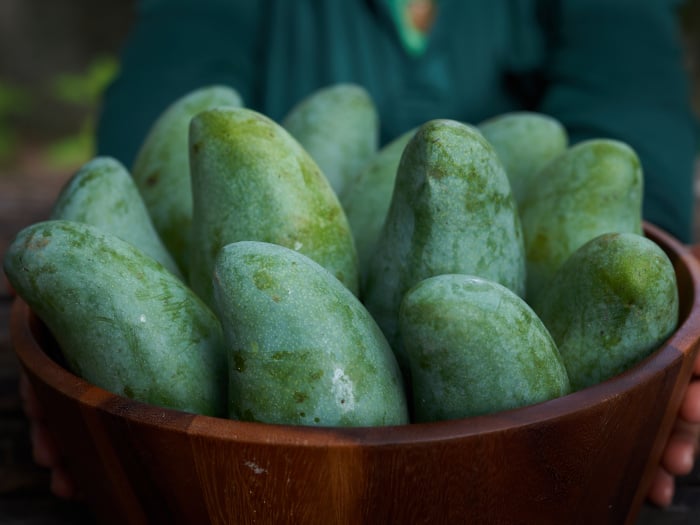Nothing marks the beginning of tropical summers quite like the arrival of the green mango. All through spring, the tops of mango trees are covered with floral blossoms, giving them various hues from white to pink. Come summer and these flowers have transformed into the raw, green mangoes. Most varieties are left alone for them to turn into a yellow-orange, ripened sweet fruit. But the tangy, raw green mango is a delicacy in its own right, and it would be remiss to not have a taste of this tropical treat before you can switch to a full-blown summer with sweet mangoes.
What is Green Mango?
If you have wondered about what a green mango is or how it is different from the yellow one, the answer is simpler than you would expect. Green mango is the sweet, yellow mango when it is raw. It is safe to eat and a very common seasonal specialty in areas where it is native. While you need to cut the pulp off the peel of ripe mango, the green mango can be eaten along with the skin. However, ensure that you thoroughly wash it.
Depending on the variety of mango, where it is being grown, and other factors, some mangoes are allowed to ripen on or off the trees, whereas some are harvested especially to be had raw. Various regions make use of these in various forms. The taste and texture of green mango are different from the ripe ones. [1]

Green mangoes are best used fresh. Photo Credit: Shutterstock
How to Eat Green Mango?
Mangoes are a seasonal fruit. The best time to get fresh mangoes is summer, which means the best time to enjoy some raw, green mango is somewhere through spring and summer. This depends on the variety of mango you are getting and where you are getting it from. The mango growth cycle is spread over months.
There are several traditional ways you can preserve green mango to be able to enjoy it all year round, though most of them alter the taste to some extent. But if you are anything like me, nothing matches the joy of cutting up a raw mango, peel intact, sprinkling it with salt and paprika, and having your mouth water all that while before you can finally take a bite.
However, the tolerance for such hard-core adventure lessens with adulthood. This does not mean we wait for mangoes to ripen, like our age. Instead, we find different ways of relishing raw mango. Here are a few ways how you can eat green mango.
- In a salad: This is the adult version of eating the fruit directly. For a basic salad, start with chopped green mango, chopped onion, some cumin powder, paprika, crushed fresh mint, salt, and sugar. Top it with mustard seeds, cumin, and asafoetida tempering. Mix it well and pair it with summer recipes.
- Use it in cooking: If you are preparing seafood or curries, raw mango finds a place in these recipes. You can juice it and use it instead of tamarind or vinegar if the recipe calls for it.
- In a pickle: There are several raw mango pickle recipes from different regions. This way, you will also be able to preserve them till you find the next fresh batch.
- In a jam: You can cook a raw mango to break it down. Adding sugar helps you preserve it for a longer time, while also lowering the sourness a bit. An Indian way of preparing green mango jam involved grating the fruit and cooking it with sugar, cloves, and a pinch of saffron, to be stored for a long time.
- Make a chutney: All through the Indian subcontinent, the use of raw mango in chutneys is abundant. To make a basic chutney, throw some green mango, green chili, salt, and coriander in a blender and give it a couple of pulses till you achieve a thick liquid consistency. With a mustard seed tempering to finish it, you can use it as a dip.
Unless it is readily accessible to you, there is often not enough raw mango to try each of these ways of enjoying it. Moreover, you cannot store the fruit for long as it will ripen into a sweet mango, which is not the same thing. If you are completely new to green mango and are wondering how to make the best use of them, these were some of the ways we recommend you start with.
If you have any fun, new ways of enjoying green mango, drop us a line in the comments section below!
